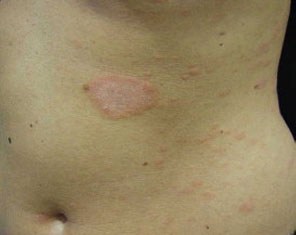Pityriasis Rosea

Pityriasis rosea: This common skin disease causes patches on the skin. Your dermatologist may call the large patch a mother patch. The smaller patches are daughter patches.
Pityriasis rosea (pit-uh-rahy-uh-sis row-zee-ah) is a common skin disease that causes a rash. This rash usually disappears on its own without treatment. You can expect to see the rash for about 6 to 8 weeks. Sometimes the rash lasts much longer.
This rash can be very itchy.
Some people who develop this rash see a dermatologist to get treatment for the itch.
If this rash appears during pregnancy, a woman should tell her doctor.
Pityriasis rosea: Diagnosis, treatment, and outcome
How do dermatologists diagnose pityriasis rosea?
A dermatologist is usually the doctor who diagnoses pityriasis rosea. The rash is often easy for a dermatologist to recognize, but not always. In some patients, this rash can look like another skin disease. It can look like ringworm or a type of eczema called nummular dermatitis.
Sometimes a dermatologist has to order tests to make sure. A dermatologist may order blood tests or remove a bit of the skin to be certain.
How do dermatologists treat pityriasis rosea?
Pityriasis rosea usually goes away without treatment. You can expect to have the rash about 6 to 8 weeks before it disappears. Some people have it for 2 weeks. Occasionally, it lasts longer than 8 weeks.
If a patient has unbearable itching, a dermatologist may prescribe a medicine to help relieve the itch. Sometimes a dermatologist prescribes light treatments for the itch.
Outcome
Most people never have another outbreak of pityriasis rosea.



